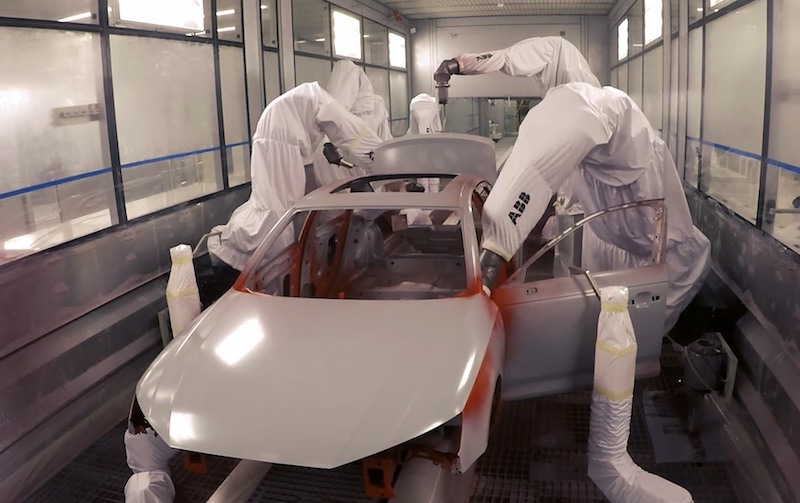
ABB Robotics is helping Audi achieve high levels of quality and consistency in its sealing and coating operation
 With automated painting processes at Audi’s plant in Changchun, China, clean and shining Audi A4Ls are rolling out one by one. This paintshop includes under-body coating, interior seam sealing, cosmetic sealing and three workstations (prime coat, base coat and clear coat lines).
With automated painting processes at Audi’s plant in Changchun, China, clean and shining Audi A4Ls are rolling out one by one. This paintshop includes under-body coating, interior seam sealing, cosmetic sealing and three workstations (prime coat, base coat and clear coat lines).
During the car bottom-coating process, ABB robots are able to clean the nozzle automatically and blow off any remaining material to make sure of a good quality seam application. With under-body coating processes, the car body is protected from rust, dust and water to improve durability. Before interior seam sealing, a vision system records the position of the car twice at the paintshop. The first position is the car body position, the second is the paint robot’s working area.
During the cosmetic sealing process, a 3D camera positioning-based BK laser system is used. It determines the exact position of a particular part of car body. The accuracy is about 0.1mm. With ABB robots’ help, this is the first cosmetic sealing application for paint process automation within China.There is a gap of only 2-3mm between door and body. ABB paint robot’s best 0.3mm accuracy ensure that an edge of rock panel coating is delivered without overspray and there are no coating particles.
 During the primer coating process, ABB’s paint robot can expel dust and complete preliminary cleaning for the car body. Next, the robot tracks the car body and wipes it.At the dry paintshop, ABB robots provide high quality painting automation without operator ‘touch-ups’. Atomisers can be cleaned automatically to avoid contamination that would adversely affect production. T
During the primer coating process, ABB’s paint robot can expel dust and complete preliminary cleaning for the car body. Next, the robot tracks the car body and wipes it.At the dry paintshop, ABB robots provide high quality painting automation without operator ‘touch-ups’. Atomisers can be cleaned automatically to avoid contamination that would adversely affect production. T
his helps to improve production efficiency and shortens cycle times. The interior painting station adopted the ABB robot IRB 5400 and IRB 5350, providing a smart function that can quickly return equipment to the home position and recover production while the robot shows any error message.
The ABB robots integrated the seven-axis, rail based lubrication system oil by automated operations volume determination in order to reduce labour requirements and ensure reliable equipment operations. Rotational colour changer valve can avoid cross colour physically and ensure high paining quality. “Push Out” function reduce the colour change time by 20%. In the clear-coating process, Audi started to partner with ABB and provide the first car body painting in October, 2015. Now, all new Audi A4Ls are moving down the production line and into the markets with the help of the ABB robots.
World’s first collaboration that focuses on ‘cobots’ and creation of common industry approaches to safety, programming and communications
ABB and Kawasaki Heavy Industries, two global industrial automation and robot suppliers, will, effective immediately, join forces to share knowledge and promote the benefits of collaborative robots, in particular those with dual arm designs.
Under the new cooperation, which is the world’s first to focus on ‘cobots,’ both robot makers will continue independentlymanufacturing and marketing their own offerings while working together on joint technical and awareness opportunities. This includes educating policy makers, NGOs and the general public about the benefits of collaborative automation, and creating common industry approaches to safety, programming and communications.
Collaboration between people and robots, machines and processes is increasingly important as production in many industries has shifted from larger lots with little variation to low volumes with a high mix. This means more variability and more human intervention. Collaborative automation allows people and robots to each contribute their unique strengths – people offer process knowledge, insight and improvisation for change, while robots offer tireless endurance for repetitive tasks.The cooperation also represents collaboration across borders, with ABB as Europe’s largest robot supplier and Kawasaki one of Asia’s industrial giants. “The scale and pace of change in the robotics industry today is unimaginable,” says Per Vegard Nerseth, managing director of ABB’s Robotics business. “Beyond the technologies behind collaborative automation, there is also a need for innovative new ways of working together and creating common industry approaches to safety, programming and communications.”
Yasuhiko Hashimoto, managing executive officer and general manager of Kawasaki Robot Division , adds: “Collaborative robots, especially those with two arms capable of human interactions, can greatly contribute to society and help the world cope with labor shortages and an ageing workforce. We see high potential in expanding collaborative applications and processes where people and technology work together to create solutions.
“I’m very pleased that ABB and Kawasaki are joining forces to lead the drive for more user-friendly, advanced collaborativeautomation.”
ABB is recognised as a pioneer in collaborative automation through its YuMi dual arm robot, the world’s first truly collaborative robot. The YuMi robot makes it possible for people and robots to safely share common tasks such as assembling small electronics.
Kawasaki is offering a very unique and innovative Dual-Arm SCARA Robot “duAro”, which has been developed based onextensive application know-how and which can safely collaborate with humans in the workplace.
The first output from this cooperation was a collaborative dual arm robot demonstration at IREX, held in Tokyo, December 2017.




































